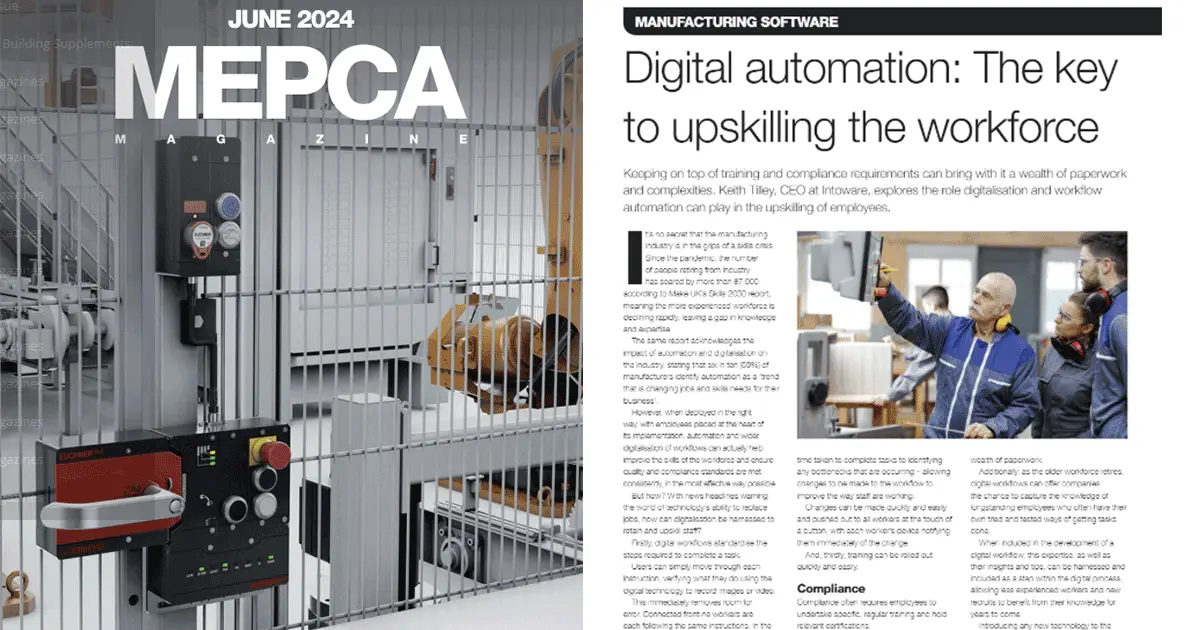Keeping on top of training and compliance requirements can bring with it a wealth of paperwork and complexities. What role can digital automation, along with digitalisation and workflow automation, play in the upskilling of employees? Keith Tilley, CEO at Intoware Ltd, explores:
It’s no secret that the manufacturing industry is in the grips of a skills crisis. Since the pandemic, the number of people retiring from industry has soared by more than 87,000 according to Make UK’s Skills 2030 report. This means the more experienced workforce is declining rapidly, leaving a gap in knowledge and expertise.
The same report acknowledges the impact of automation and digitalisation on the industry. It states that six in ten (59%) of manufacturers identify automation as a ‘trend that is changing jobs and skills needs for their business’.
However, when deployed in the right way, with employees placed at the heart of its implementation, automation and wider digitalisation of workflows can actually help improve the skills of the workforce. This ensures quality and compliance standards are met consistently in the most effective way possible. This is where digital automation excels.
But how? With news headlines warning the world of technology’s ability to replace jobs, how can digitalisation be harnessed to retain and upskill staff?
Firstly, digital workflows standardise the steps required to complete a task.
Users can simply move through each instruction, verifying what they do using the digital technology to record images or video.
This immediately removes room for error. Connected frontline workers are each following the same instructions in the same way. This provides peace of mind and accountability when it comes to compliance. It ensures less experienced workers who are new to the company, or who’ve been redeployed, remain consistent and learn fast. Digital automation helps reduce these errors significantly.
Secondly, the process of following a digital workflow means data is being continually captured in real-time.
This data provides valuable insights into the operations of a manufacturer – from the time taken to complete tasks to identifying any bottlenecks that are occurring. This allows changes to be made to the workflow to improve the way staff are working. Automation in digital processes indeed brings remarkable benefits.
Changes can be made quickly and easily. These changes are then pushed out to all workers at the touch of a button, with each workers’ device notifying them immediately of the change.
And, thirdly, training can be rolled out quickly and easily.
Compliance often requires employees to undertake specific, regular training and hold relevant certifications.
Digital workflows can be used to create training programmes. This makes it easy to track and manage what training has been completed by which user.
So, if there’s a clear skills gap within the team, training can be implemented fast and recorded digitally. This ensures all workers are equipped with the knowledge they need to do their job well, and can enhance their development regularly without the need for a wealth of paperwork.
Additionally, as the older workforce retires, digital workflows can offer companies the chance to capture the knowledge of longstanding employees. These employees often have their own tried and tested ways of getting tasks done.
When included in the development of a digital workflow, this expertise, as well as their insights and tips, can be harnessed as a step within the digital process. This allows less experienced workers and new recruits to benefit from their knowledge for years to come. This process is greatly enhanced by digital automation.
Introducing any new technology to the workforce can be a daunting prospect. However, with the right processes in place to ensure employees feel engaged and informed about the changes, digital workflows can be the key to not only increasing productivity and efficiency. They also ensure the team has the skills it needs to do the job well, every time – now and in the future. This is the promise of digital automation.

